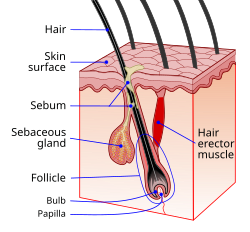Sebaceous glands
| Sebaceous gland | |
|---|---|

Schematic view of hair follicle and sebaceous gland.
|
|

Cross-section of all skin layers. A hair follicle with associated structures. (Sebaceous glands labeled at center left.)
|
|
| Details | |
| Identifiers | |
| Latin | glandula sebacea |
| MeSH | A10.336.827 |
| TA | A16.0.00.030 |
| FMA | 59160 |
|
Anatomical terminology
[]
|
|
Sebaceous glands are microscopic exocrine glands in the skin that secrete an oily or waxy matter, called sebum, to lubricate and waterproof the skin and hair of mammals. In humans, they occur in the greatest number on the face and scalp, but also on all parts of the skin except the palms of the hands and soles of the feet. The type of secretion of the sebaceous glands is referred to as holocrine.
In the eyelids, meibomian glands, also called tarsal glands, are a type of sebaceous gland that secrete a special type of sebum into tears. Fordyce spots are ectopic (misplaced) sebaceous glands found usually on the lips, gums and inner cheeks, and genitals. Areolar glands surround the female nipples. Preputial glands also known as Tyson's glands are found in the genitals of both sexes of mice and rats.
Several related medical conditions involve sebum—including acne, sebaceous cysts, hyperplasia, and sebaceous adenoma. These are usually attributable to overactive sebaceous glands, which produce excess sebum.
The sebaceous glands are found throughout all areas of the skin except the palms of the hands and soles of the feet. There are two types of sebaceous gland, those connected to hair follicles, in pilosebaceous units, and those that exist independently.
...
Wikipedia
